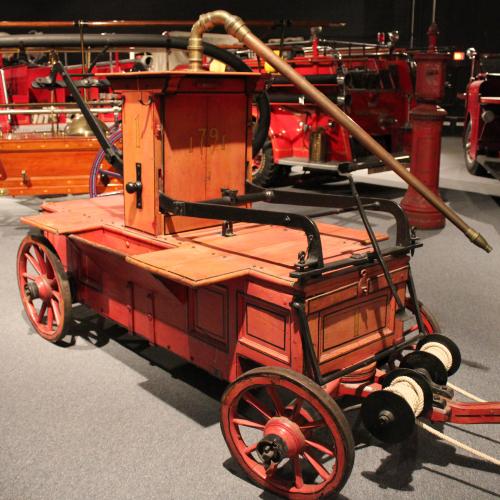
“Peter on Duty,” by Charles T. Hill, 1896
Some breeds of dogs, most famously the iconic, black-spotted Dalmatian, have served with firefighters for centuries. As a breed, Dalmatians have a natural affinity with horses and were used as stable and carriage guards, hence their integration into fire service as early as the mid-1700s.
Company mascots also sounded the alarm, running in front of the engine barking to make sure people got out of the way of the oncoming engine.
(Image courtesy of Fighting a Fire, New York State Library, Manuscripts and Special Collections, 352.3 H64)
Fire Engine Hall
Fear Not, We Come!
More than machines, fire engines can be seen as works of art and are symbols of civic spirit.
Since the colonial period in America, fire companies and their engines have played a central role in protecting and celebrating their communities. New York State was a leader in innovation and production of fire-protection apparatus and gear during the 19th and 20th centuries. Hand engines, steam engines, water systems, hydrants, motorized fire apparatus, equipment, and gear were all produced in New York State.
This exhibition highlights trends in the evolution of firefighting apparatus, starting from the colonial period through the mid-20th century. From villages to army bases to New York City, each piece of equipment represents a community’s effort to more efficiently battle fires, and to save lives and structures.
Apparatus in this gallery has helped firefighters save countless lives over the centuries! See everything from hand-drawn and horse-drawn apparatus to motor-powered vehicles. Additional objects—including gear, tools, and other ephemera—show how technology has changed over the years, and offer insight into the culture and tradition of firefighting. Retired Fire Department of the City of New York Captain Brenda Berkman’s badge is on loan. Berkman led the charge to give women a fair chance to join FDNY. Historical images, many from our partners in the New York State Library, Manuscripts and Special Collections show firefighters in action and equipment in use.
1791 Tub
This hand engine, filled by buckets instead of a hose, is the Musuem's oldest piece of fire equipment on display in Fire Engine Hall. Retired in 1832, it was preserved by the Lansingburgh (later part of Troy) fire department for over 100 years until it was donated to the State Museum in 1937.
1875 Parade Carriage
This intricately adorned fire carriage was never intended to actually fight fires. Rather, it represented the pride that 19th-century volunteer fire departments took in their apparatus and was meant to dazzle on display in community parades. This hand-pulled carriage, with a dummy hose reel, featured velvet panels, beveled mirros, engraved gas lamps, and even an oil portrait!
Speaking trumpet, Washington Hose Company #12 of New York City, c. 1850
Before radios and bullhorns, speaking trumpets were used to amplify verbal orders at a fire scene. Ceremonial speaking trumpets with elaborate designs were often given to retiring chiefs or as gifts from one company to another when visiting. In parades today, firefighters still carry ceremonial trumpets, often with a bouquet of flowers placed in the horn.
Fun Facts: Did you know?!
Sounding the Alarm
Early fire alarm systems included the "rattlewatch." Initiated in 1658, it consisted of a group of men who patrolled the towns at night and would shake loud wooden rattles to alert the townspeople of a fire.
The Bucket Brigade
The earliest weapon colonists had to fight fires was the leather bucket. Most municipalities had rules requiring homeowners to have a certain number of them. In the event of a fire, all able-bodied adults were expected to bring their buckets to assist in the bucket brigade. Most commonly, men would pass the filled buckets, weighing around 12 pounds, and women would pass back the empty ones.
Related Videos
Here’s a behind-the-scenes look at the creation of a custom mural produced by our Museum staff as part of our updates to Fire Engine Hall in 2024.







